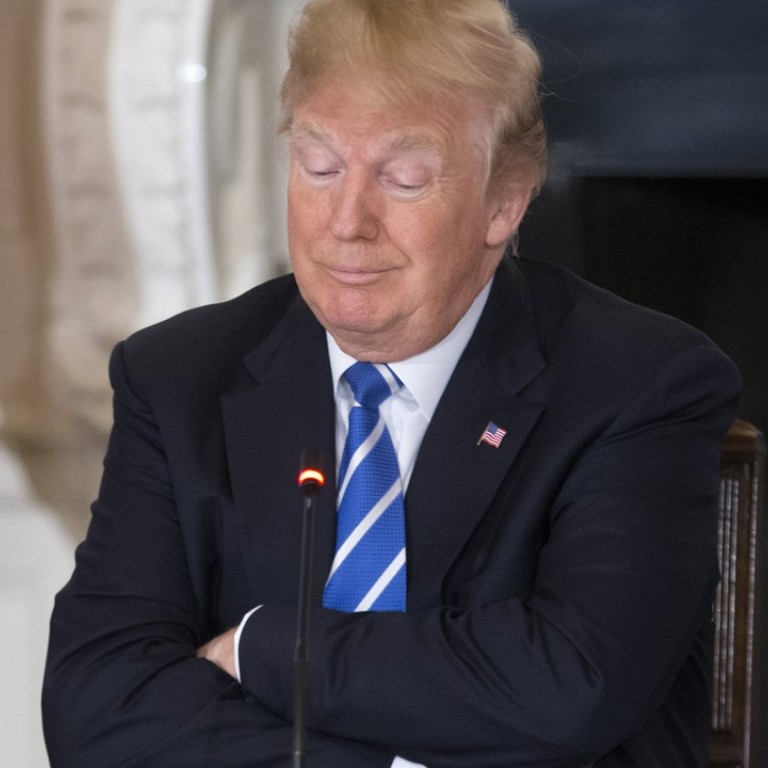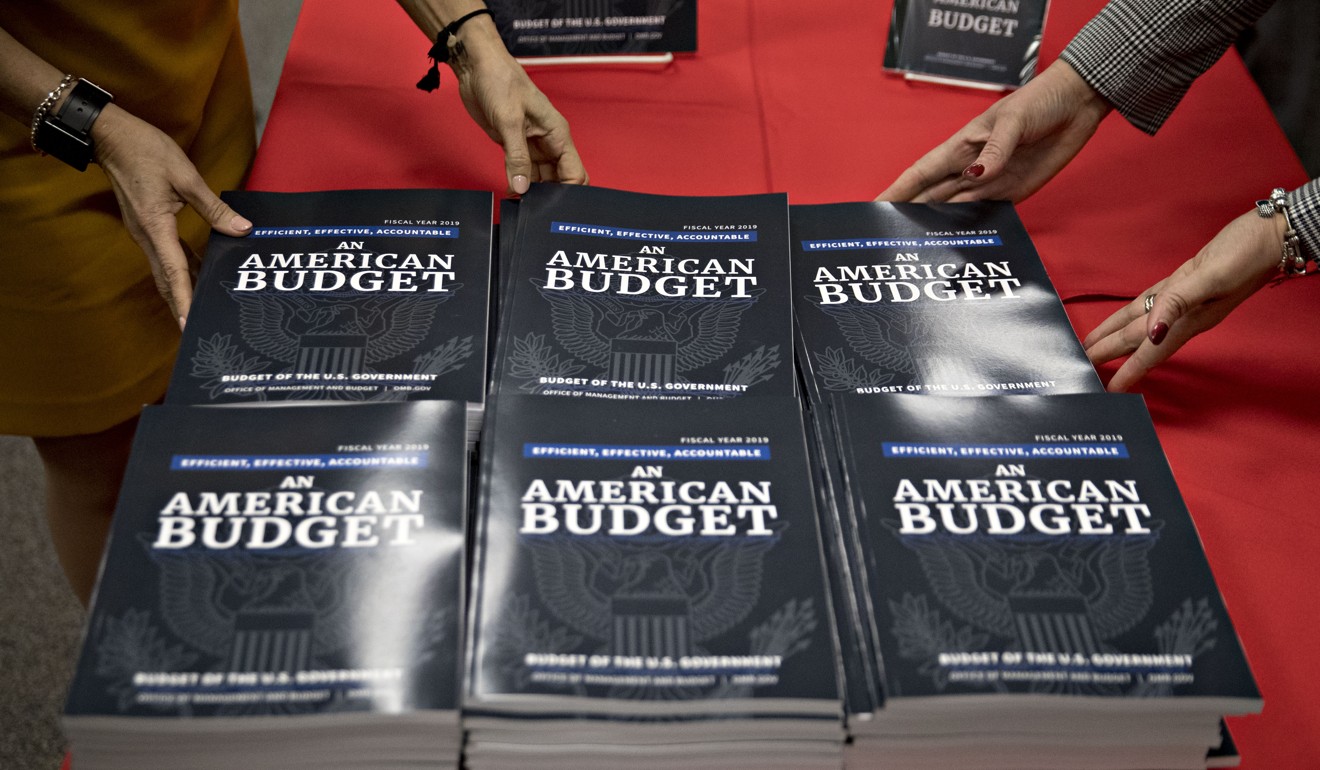
‘This is a joke’: Trump’s ambitious plan for growth virtually impossible, experts say
His budget predicts the longest expansion in US history, with moderate inflation and unemployment falling to 3.7 per cent in 2019, the lowest level since 1969
President Donald Trump is beginning his second year in office with a high-risk strategy: juicing the US economy at a time when it already looks pretty healthy. As his latest budget, released on Monday, makes clear, Trump wants growth of 3 per cent – or more – a year for the next seven years, a feat that has not happened since Ronald Reagan was president in the 1980s.
Most economists say Trump’s economic dream is virtually impossible. The latest Survey of Professional Forecasters, for example, does not predict growth will hit 3 per cent at all in Trump’s first term. The United States is in a different place today than it was three decades ago, many say. The population is much older now, making it more difficult to sustain higher growth, especially without additional immigration or some sort of technological revolution that would make American workers the most productive they have been since the 1960s.
But Trump does not like being told no. He is made a career out of defying the odds, and his “Trumponomics” recipe of cutting taxes and hiking spending is meant to spur so much additional business investment that productivity can hit record levels. In theory, that would then boost growth and wages further.
I would love if we had 3 per cent growth for two years, let alone seven years, but we have an ageing population
His budget predicts the longest expansion in US history, with moderate inflation and unemployment falling to 3.7 per cent in 2019, the lowest level since 1969. Some economists, however, say the more likely result is growth picks up for a year or so and then a downturn hits. By then, the US government would be even deeper in debt with less money to spend to revive the economy.
“This is a joke,” said Marc Goldwein, senior policy director at the Committee for a Responsible Federal Budget. “I would love if we had 3 per cent growth for two years, let alone seven years, but we have an ageing population and there is no plausible story I can tell where we’re on a path toward sustained economic growth at that level.”
Friction over these contrasting views of how Trumponomics is likely to play out are causing some of the stock market whiplash. There’s broad agreement that this year looks good. There’s a lot of disagreement about what comes in 2019 and beyond.
“The stock market gyrations we’re seeing now might be a foreshadowing of some kind of downturn,” said Kristina Hooper, chief global strategist at Invesco. “It seems likely before the end of 2019, we will probably see some kind of economic slowdown.”
Increasingly, Wall Street banks and independent economic researchers are starting to flag doubts about the health of the Trump economy, further fuelling the belief that a downturn could hit in 2019. The thinking is that the economy is likely to overheat, forcing the Federal Reserve to have to hike interest rates quickly to prevent inflation, where prices rise rapidly on everything from rents to food to gas. Once the Fed starts pumping up rates, business and consumers are likely to pull back their spending.

“2018 is likely to be as good as it gets,” said Paul Ashworth, chief US economist at Capital Economics. “The slowdown may not necessarily come in first half of 2019, but maybe the second half as there’s a bigger drag from tighter monetary policy and the fiscal stimulus wears off.”
In a further strike on the Trump economy, Goldman Sachs said the president’s deregulation push is having little to no effect on the economy. “Overall, our results suggest that non-financial deregulation has had a limited impact on the economy to date,” the bank wrote in a report over the weekend.
Goldman’s research follows on the heels of a Morgan Stanley report last week that looked at what 556 companies are likely to do with their tax savings. The survey found 43 per cent intend to fatten dividends and share buy-backs. The next most popular use of the tax money is likely to be mergers (19 per cent said this). Only 17 per cent anticipate more capital spending and only 13 per cent think higher wages are likely. A Bank of America survey in August of over 300 companies found similarly pessimistic expectations for how the tax savings would likely be used.
Trump is counting on much of the tax savings going toward business investment. If business spending does not pick up, there’s even less likelihood of years of great growth. Capital spending did pick up last year and small business confidence is at its highest levels since the Reagan era, but that optimism has to continue to fuel investment.
On the upside for Trump, growth came in stronger than the experts anticipated last year. Americans are feeling the uptick. The latest Quinnipiac University Poll found that 70 per cent of Americans rate the economy as “excellent” or “good,” the highest rating since the poll started asking this particular question in 2001. And for the first time in his presidency, more Americans credit Trump with driving the economic gains than former president Barack Obama.
But moods can shift quickly, especially if bond yields start rising and the stock market sells off for a prolonged period of time.
Trump’s budget projects a lot more debt in the coming years, an oddity at a time of healthy growth when governments typically try to get their budgets back in line. Independent groups like the Committee for a Responsible Federal Budget anticipate the deficit will hit US$1 trillion by next year, a record level at a time when unemployment is so low. The Trump Administration isn’t quite that high, but even it anticipates a US$873 billion deficit this financial year and US$984 billion in 2019.
Trump has abandoned his promise to balance the budget in the next decade. Instead, his latest budget runs a deficit every year. “This is a step in the wrong direction,” said Doug Holtz-Eakin, president of the right-leaning American Action Forum and an economic adviser to Republican Party politicians.
Even with the large cuts Trump proposes for many programmes that aid the poor, he still isn’t able to balance the budget. In fact, the budget released Monday has $2.7 trillion lower revenue over the next decade than his first budget projection in May did, a seeming admission that the tax cuts would struggle to produce enough revenue to offset the costs.
“Their budget effectively assumes that tax cuts don’t pay for themselves,” said Jason Furman, a Harvard professor who was head of President Obama’s Council of Economic Advisers.
Mick Mulvaney, Trump’s budget director, argues the government would bring in more money because of the tax cuts than it would have without them.
“As long as we’ve got GDP growing fast … the deficit will be going down,” said Mulvaney, who used to champion balanced budgets as a congressman.
The Trump administration is on track to return to levels of borrowing not seen since the crisis. While demand from China, Japan and elsewhere in the world is still strong for US government bonds, it’s a gamble. If foreign governments slow down their purchases, yields would likely spike.
Trump’s budget assumes borrowing rates for the 10-year Treasury bonds will remain low, even as growth picks up and unemployment falls further. The budget predicts the popular 10-year US Treasury bond will have a 2.6 per cent yield this year. At the moment, the yield is over 2.8 per cent, meaning borrowing costs are higher than the administration wants.
For now, many economic metrics look good. But the Trump administration foresees an even stronger economy for years to come. Outside economists see a rising possibility of a downturn. Trump is hoping for a Reagan-like economy. He might end up with a President George H.W. Bush one, where a slowdown comes just as he is campaigning for a second term.

